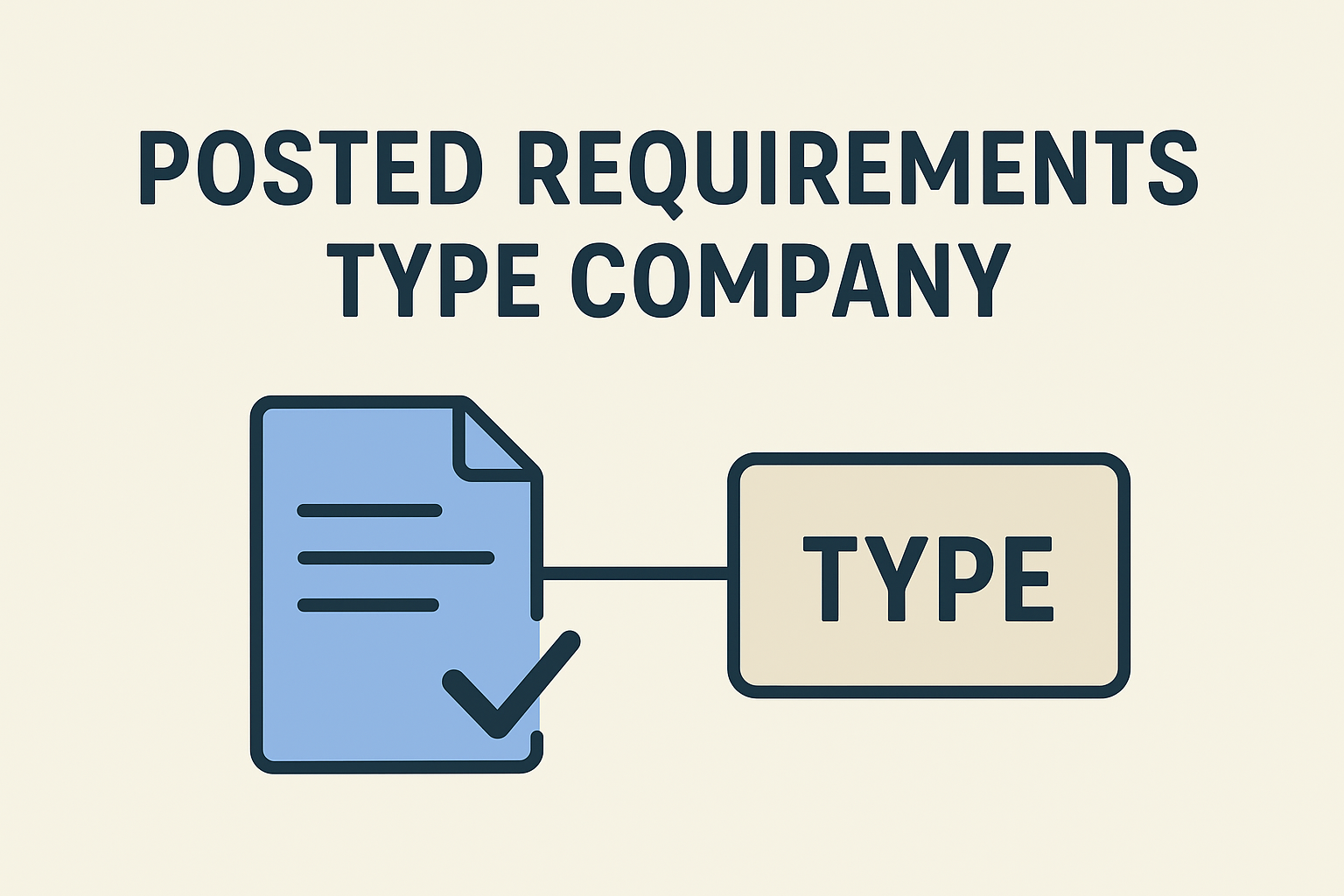PostedRequirementsTypeCompany – Understanding the Idea from Ground Up
“postedrequirementstypecompany” If you work in business, project management, or even in a freelance market, you’ve probably come across situations where a company lists something they need. Sometimes it’s a job opening, sometimes a supply request, other times it’s a project brief. In corporate language, these are called posted requirements. And when people say postedrequirementstypecompany, they are often talking about the practice of a company putting out these requirements, along with a clear classification or “type” for them.
It sounds technical, but the idea is simple:
A business has a need → it defines that need clearly → it posts it where relevant people can see it. The “type” helps sort and filter those needs, so they reach the right audience.
Breaking Down the Term
Let’s split this slightly awkward-looking phrase into its parts.
- Posted: Something made visible or published.
- Requirements: What the company needs could be goods, services, people, or expertise.
- Type: The category or classification of that requirement.
- Company: The entity that is posting it.
When you put them together, you have a situation where a business publicly or internally shares what it’s looking for, tags it with a category, and makes it available for responses.

Why Companies Post Requirements
There’s a practical reason behind it. Businesses survive and grow by solving problems and meeting objectives. They can’t do everything in-house. So they rely on others employees, contractors, suppliers, agencies to fulfill certain needs.
Here are some real-world examples:
- A hospital posting requirements for medical-grade oxygen suppliers.
- A tech startup posting a requirement for a mobile app developer who understands blockchain integration.
- A marketing firm posting a requirement for a freelance copywriter with experience in B2B campaigns.
By posting these needs and categorizing them, companies save time and make sure only the right people apply or respond.
Read other topic Understanding Camyentruoc: A Closer Look at Prohibiting Beforehand
The Role of “Type” in the Process
Without classification, posted requirements can become a messy list. Imagine scrolling through a list of job openings without knowing which ones are full-time, part-time, remote, or internship. Or browsing procurement listings with no idea which ones are urgent or recurring.
The “type” could indicate:
- Job type (permanent, temporary, remote, hybrid)
- Service type (consulting, supply, repair)
- Urgency level (immediate, medium-term, long-term)
- Industry category (IT, healthcare, construction, education)
This small label makes a huge difference in connecting the right provider with the right opportunity.
Posted Requirements in Recruitment
Recruitment is probably the most familiar example of this concept. Human resources departments and hiring managers post job openings with detailed descriptions. The “type” here might be the job category or employment type.
For instance:
- “Senior Backend Developer – Full-time, Onsite”
- “Sales Representative – Commission-based, Remote”
A clear type helps job seekers quickly understand if they should apply. It also reduces the workload for recruiters because they don’t have to sift through dozens of irrelevant applications.
Procurement and Vendor Selection
Procurement teams deal with posted requirements almost daily. Large companies, especially those in manufacturing, construction, or government sectors, often publish requests for suppliers. These postings are sometimes called RFPs (Requests for Proposal) or RFQs (Requests for Quotation).
Here, the “type” might be:
- Product category (electronics, raw materials, office supplies)
- Contract type (one-time purchase, annual supply agreement)
- Compliance type (ISO-certified suppliers only, eco-friendly materials)
A steel plant, for example, might post a requirement for high-carbon steel rods with specific tensile strength, delivery timeline, and certification requirements. The posted type ensures only qualified vendors respond.
Collaboration and Outsourcing
In collaborative projects, especially those involving multiple companies or international teams, posted requirements function as task assignments. A digital marketing agency might post a requirement for video editing with a “type” marked as “short-form content” for social media. This ensures the right creative professionals pick it up.
Benefits of Posting Requirements Clearly
Transparency
When everyone can see exactly what’s needed, there’s less room for misinterpretation. Clear postings set expectations upfront.
Efficiency
Time is saved when interested parties can self-assess their suitability before engaging.
Better Quality Responses
Vague postings attract mismatched applicants or vendors. Clear type labels improve the quality of proposals or applications.

Common Mistakes in Posted Requirements
Being Too Vague
If a requirement says only “Need IT support,” it could mean anything from fixing office printers to setting up a corporate cloud server. Lack of detail wastes everyone’s time.
Wrong Classification
If a company tags a short-term freelance role as a “full-time” position, many suitable candidates might ignore it.
Forgetting to Update
An outdated posting still visible on a company’s site can cause confusion and even harm the brand’s credibility.
Best Practices for Writing Posted Requirements
- Be Specific – Include exact specifications, timelines, and deliverables.
- Use Clear Types – Don’t create too many confusing categories; stick to terms people understand.
- Update Regularly – Remove fulfilled requirements and refresh ongoing ones.
- Think About the Reader – Write so the intended audience instantly knows if it’s relevant to them.
Technology’s Role in Managing Requirements
Today, many businesses use digital tools for this process. Internal company portals, cloud-based procurement systems, and job listing software make it easier to post, classify, and manage requirements.
Some companies even use automation to:
- Post the same requirement to multiple platforms at once.
- Notify relevant vendors or job seekers instantly.
- Archive completed postings for future reference.
Industry Examples
- IT Services: Software firms post requirements for security audits, cloud migration, or specialized coding tasks.
- Construction: Builders post requirements for scaffolding, safety gear, or subcontractor teams.
- Healthcare: Hospitals post requirements for specialist doctors, nursing staff, or medical equipment.
- Education: Universities post requirements for research assistants or lab equipment.
Global Reach of Posted Requirements
The internet has erased many geographical limits. A design agency in Paris can post a requirement for a 3D animator, and a freelancer in Manila can apply. This global reach means companies can find talent or suppliers faster, but it also requires clear legal and logistical planning.

The Future of Posted Requirements
With AI and data analytics, the process is likely to become predictive. Instead of waiting for a need to arise, systems may identify patterns and suggest posting a requirement in advance. Classification might become smarter, automatically tagging the requirement based on the content of the post.
In the long run, companies that excel in clear, well-typed requirement postings will have an edge in attracting the right talent, resources, and partners.
FAQs for postedrequirementstypecompany:
Q1: What does “postedrequirementstypecompany” actually mean?
It refers to a company publishing its needs or requests whether for products, services, or talent along with a clear classification or category to help the right people respond.
Q2: Where are posted requirements usually published?
They can appear on company websites, job boards, procurement portals, or internal platforms used by employees and partners.
Q3: Why is the “type” important in posted requirements?
The type helps filter and organize postings so only relevant candidates, vendors, or collaborators engage with them, saving time for everyone involved.
Q4: Is this process only for large companies?
No. Small businesses, startups, and even individual freelancers can use posted requirements to communicate their needs clearly and efficiently.
Q5: How often should a company update its posted requirements?
As soon as the need changes or is fulfilled. Outdated listings can confuse potential applicants or suppliers and harm the company’s reputation.
Q6: Can posted requirements be used for international collaboration?
Absolutely. With online platforms, companies can share requirements globally, attracting suppliers or professionals from anywhere in the world.
Q7: What’s the risk of posting unclear requirements?
Vague or incomplete postings can attract unqualified responses, waste time, and delay projects.
Q8: Are there tools to manage posted requirements efficiently?
Yes. Many companies use procurement software, applicant tracking systems, or project management tools to post, categorize, and track requirements in real time.














Post Comment